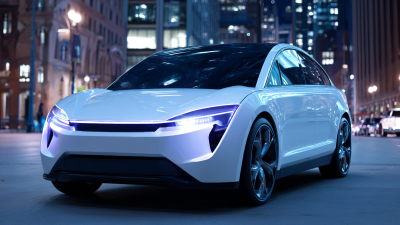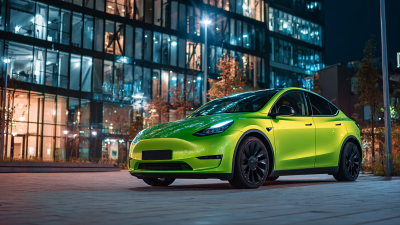As the automotive industry continues to evolve towards sustainable alternatives, the demand for the Longest Range Electric Car has surged among environmentally conscious consumers and tech enthusiasts alike. These cutting-edge vehicles not only promise extended driving ranges but also offer innovative features and technologies that enhance the overall driving experience. In this blog, we will explore a variety of solutions designed to maximize your experience with the Longest Range Electric Car, from optimizing your charging routine to utilizing advanced navigation tools that calculate routes based on charging station availability. By harnessing the power of digital technologies and leveraging top-tier features, drivers can ensure that their electric vehicle journeys are as seamless and enjoyable as possible. Join us as we delve into actionable tips and expert insights that will help you make the most out of your Longest Range Electric Car adventure.

Long-range electric cars have surged in popularity, thanks to advances in battery technology and growing consumer demand for sustainable transport. Understanding the key features that maximize the experience with these vehicles is essential for potential buyers. A report from the International Energy Agency (IEA) indicates that the global electric vehicle market is projected to reach 145 million units by 2030, primarily driven by the appeal of longer ranges, with several models now exceeding 300 miles on a single charge.
One of the primary features to consider is battery capacity, typically measured in kilowatt-hours (kWh). A larger capacity generally leads to a greater driving range, allowing drivers to travel longer distances without worrying about frequent charging. Recent advancements have seen batteries surpassing 100 kWh in models like the Tesla Model S and Lucid Air, allowing for ranges of over 400 miles. Additionally, efficient regenerative braking systems contribute to extending range by converting some of the energy used in acceleration back into energy during deceleration, enhancing overall efficiency.
Charging infrastructure is another vital aspect. As per the U.S. Department of Energy, the number of public charging stations has increased significantly, with over 41,000 stations and 100,000 charging points available in the USA alone as of early 2023. This expansive network enables long-range electric vehicle owners to travel confidently, knowing they can access charging options along their routes. With these features in mind, consumers can make informed choices that enhance their driving experience and align with sustainable practices.
This chart illustrates key specifications of long-range electric cars, including battery capacity, expected driving range, and average charging time. Understanding these features can enhance your experience with electric vehicles.
As electric vehicles (EVs) become increasingly popular, planning your routes effectively is essential to maximizing your experience and minimizing range anxiety. Google Maps has recently introduced features specifically aimed at EV drivers, allowing users to filter and locate nearby charging stations with ease. This update is particularly beneficial for long-distance trips, empowering drivers to map out their journeys and identify optimal charging locations along the way.
In addition to Google Maps, various navigation apps are enhancing their services to cater to the needs of electric vehicle owners. For instance, upgrades to popular mapping platforms now include dedicated navigation for EVs, helping users find charging stations quickly. These innovations are crucial for addressing common concerns, such as how long it will take to charge and whether there will be a wait at the charging station. By utilizing advanced route-planning tools and charging maps, drivers can embark on road trips with confidence, knowing that their electric cars can handle the journey without stress.
| Route | Distance (miles) | Estimated Time (hours) | Charging Stations Available | Charging Time (hours) |
|---|---|---|---|---|
| Route A | 150 | 3 | 2 | 1.5 |
| Route B | 200 | 4 | 3 | 2 |
| Route C | 120 | 2.5 | 1 | 1 |
| Route D | 250 | 5 | 4 | 3 |
 When it comes to maximizing the experience with the longest range electric cars, maintaining battery health is crucial for optimal performance. Studies indicate that battery health can influence range efficiency by up to 30%, making it essential for electric vehicle (EV) owners to adopt best practices for care. Temperature extremes, both hot and cold, can adversely affect battery life. According to the U.S. Department of Energy, storing your EV in a garage can mitigate these temperature fluctuations, ensuring that the battery remains within its optimal operating range.
When it comes to maximizing the experience with the longest range electric cars, maintaining battery health is crucial for optimal performance. Studies indicate that battery health can influence range efficiency by up to 30%, making it essential for electric vehicle (EV) owners to adopt best practices for care. Temperature extremes, both hot and cold, can adversely affect battery life. According to the U.S. Department of Energy, storing your EV in a garage can mitigate these temperature fluctuations, ensuring that the battery remains within its optimal operating range.
Tips for preserving battery health include avoiding frequent fast charging, which can generate excess heat and degrade battery capacity over time. Instead, regular charging at home using Level 2 chargers is recommended. Furthermore, keeping the battery charged between 20% and 80% can enhance longevity; research from the University of California suggests this practice can prolong battery life by 40%. Paying attention to these simple guidelines can help you maximize the performance of your longest range electric car, allowing you to enjoy extended journeys without the worry of battery depletion.
The longest range electric cars on the market today leverage cutting-edge technology to provide an unparalleled driving experience. Advanced battery management systems, coupled with regenerative braking, can significantly maximize efficiency. According to a report from the International Council on Clean Transportation, electric vehicles (EVs) have improved their range by over 40% in just the last three years, with some models now exceeding 400 miles on a single charge. This impressive range not only alleviates range anxiety but also empowers drivers to embark on longer journeys with confidence.
To further enhance your driving experience, consider using mobile apps and in-car technology that provide real-time updates on charging station availability and route optimization. These tools can help you plan trips more effectively and ensure that you have access to the necessary charging infrastructure along your route. Additionally, integrating smart home features allows you to manage charging schedules based on electricity rates, ensuring that you maximize savings while keeping your vehicle fully charged.
Tips: Always keep your vehicle's software up to date to benefit from the latest enhancements. If you're heading out on a long trip, mapped out charging stops can save you time. Lastly, familiarize yourself with local incentives for EV owners, as many regions offer benefits that can improve your overall ownership experience.

When it comes to maximizing cost savings with long-range electric vehicles (EVs), several important factors come into play. According to a report by the International Council on Clean Transportation, longer-range EVs, typically exceeding 250 miles per charge, can significantly reduce the frequency of charging stops, which aligns with consumer preferences for convenience and efficiency. With reduced charging time, drivers can save both time and money, enhancing the overall ownership experience.
Moreover, the total cost of ownership (TCO) for long-range EVs is consistently lower than that of traditional gasoline vehicles. A study by Bloomberg New Energy Finance indicates that the lower operating costs, due to cheaper electricity prices compared to gasoline and reduced maintenance needs—since electric cars have fewer moving parts—can lead to long-term savings of around $6,000 to $10,000 over a vehicle's lifecycle. As battery technology continues to improve, these savings will only increase, making long-range EVs an economically attractive choice for consumers looking to maximize their cost savings while minimizing their carbon footprint.






